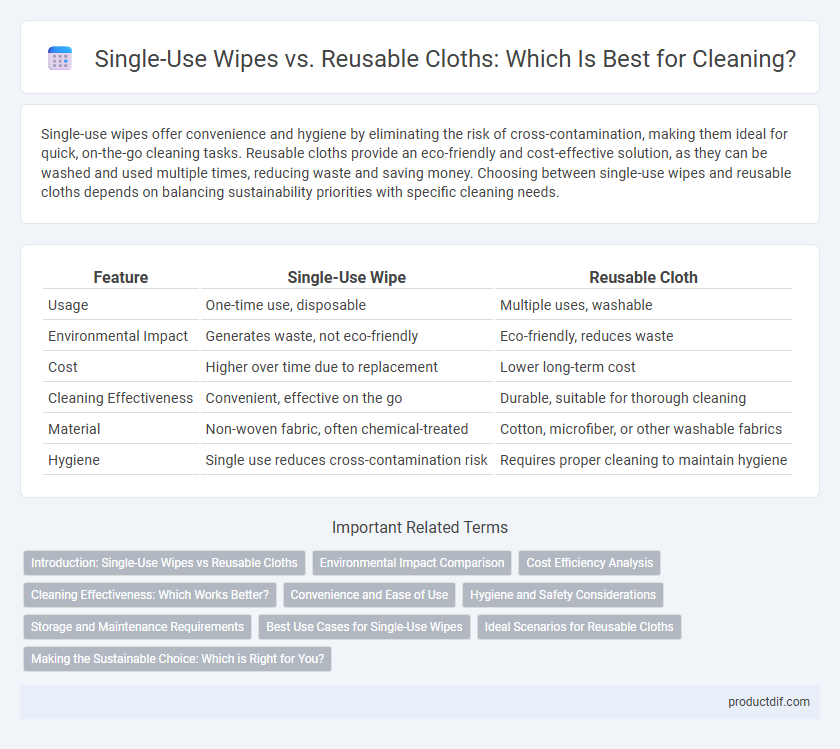Single-use wipes offer convenience and hygiene by eliminating the risk of cross-contamination, making them ideal for quick, on-the-go cleaning tasks. Reusable cloths provide an eco-friendly and cost-effective solution, as they can be washed and used multiple times, reducing waste and saving money. Choosing between single-use wipes and reusable cloths depends on balancing sustainability priorities with specific cleaning needs.
Table of Comparison
| Feature | Single-Use Wipe | Reusable Cloth |
|---|---|---|
| Usage | One-time use, disposable | Multiple uses, washable |
| Environmental Impact | Generates waste, not eco-friendly | Eco-friendly, reduces waste |
| Cost | Higher over time due to replacement | Lower long-term cost |
| Cleaning Effectiveness | Convenient, effective on the go | Durable, suitable for thorough cleaning |
| Material | Non-woven fabric, often chemical-treated | Cotton, microfiber, or other washable fabrics |
| Hygiene | Single use reduces cross-contamination risk | Requires proper cleaning to maintain hygiene |
Introduction: Single-Use Wipes vs Reusable Cloths
Single-use wipes offer convenience and effective germ removal with disposable design, reducing the risk of cross-contamination. Reusable cloths provide an eco-friendly, cost-effective option, but require regular washing to maintain hygiene and prevent bacterial growth. Choosing between the two depends on priorities like environmental impact, convenience, and cleaning efficiency.
Environmental Impact Comparison
Single-use wipes contribute significantly to landfill waste with millions discarded daily, often containing non-biodegradable materials that persist for decades. Reusable cloths, made from sustainable fibers like organic cotton or bamboo, reduce environmental footprint by minimizing waste and resource consumption over time. Life cycle assessments show reusable cloths lower greenhouse gas emissions and water usage compared to the production and disposal of single-use wipes.
Cost Efficiency Analysis
Single-use wipes tend to have a higher cost per use due to continuous repurchasing, whereas reusable cloths offer long-term savings by lasting through multiple cleaning cycles. Factoring in environmental impact, reusable cloths reduce waste generation and lower overall expenses despite the initial investment. Cost efficiency is maximized by evaluating purchase price, durability, and frequency of replacement for each cleaning product option.
Cleaning Effectiveness: Which Works Better?
Single-use wipes offer convenience and consistent cleaning performance by eliminating cross-contamination risks, making them ideal for disinfecting high-touch surfaces. Reusable cloths provide superior cleaning versatility and durability, especially when combined with appropriate detergents and regular laundering, which ensures effective removal of dirt and bacteria. Choosing between the two depends on the specific cleaning context, surface type, and hygiene requirements to maximize cleaning effectiveness.
Convenience and Ease of Use
Single-use wipes offer unmatched convenience by eliminating the need for washing and drying, making them ideal for quick, on-the-go cleaning tasks. Reusable cloths provide ease of use through their durability and ability to handle tougher grime with effective washing and reuse. Consumers often prefer single-use wipes for immediate disposal and minimal effort, while reusable cloths appeal to those prioritizing cost efficiency and environmental impact.
Hygiene and Safety Considerations
Single-use wipes offer enhanced hygiene by reducing cross-contamination risks since they are discarded after one use, making them ideal for cleaning high-touch surfaces in healthcare and food preparation settings. Reusable cloths require thorough washing and proper drying to prevent bacterial growth, which can compromise safety if not maintained correctly. Choosing between single-use wipes and reusable cloths depends on balancing environmental impact with stringent hygiene requirements in specific cleaning scenarios.
Storage and Maintenance Requirements
Single-use wipes require minimal storage space and no maintenance, making them convenient for quick, disposable cleaning tasks. Reusable cloths need proper storage in dry, clean conditions to prevent mold and bacteria growth, alongside regular washing to maintain hygiene and effectiveness. Efficient storage solutions and routine laundering extend reusable cloth lifespan, reducing environmental impact compared to frequent single-use wipe disposal.
Best Use Cases for Single-Use Wipes
Single-use wipes excel in environments requiring rapid, hygienic disposal such as healthcare settings and food preparation areas to prevent cross-contamination. Their convenience and pre-moistened formulations target stubborn stains and disinfect surfaces quickly without the need for additional cleaning agents. Ideal for on-the-go cleaning and high-traffic public spaces, single-use wipes minimize bacterial spread and ensure consistent sanitation standards.
Ideal Scenarios for Reusable Cloths
Reusable cloths excel in environments requiring frequent cleaning and sustainability, such as office spaces, households, and restaurants, where reducing waste is a priority. Their durability allows for multiple uses and effective removal of dirt, grease, and bacteria without the environmental impact of single-use wipes. Ideal scenarios also include general surface cleaning and polishing tasks where longevity and cost-effectiveness are essential.
Making the Sustainable Choice: Which is Right for You?
Single-use wipes offer convenience but create significant environmental waste due to their non-biodegradable materials and frequent disposal. Reusable cloths made from durable fibers like microfiber reduce landfill impact and require fewer resources over time, making them a more sustainable option for cleaning. Choosing between single-use wipes and reusable cloths depends on balancing immediate convenience with long-term environmental benefits and personal cleaning needs.
Single-use wipe vs Reusable cloth Infographic

 productdif.com
productdif.com